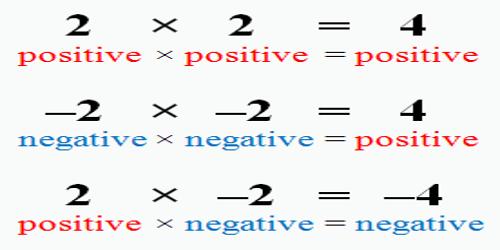

If you can remember this phrase, then it may be easier to remember the order of operations given in PEMDAS. The way I think about it is that negatives always come in pairs so they pair up and. The letters PEMDAS and the words Parenthesis Exponents Multiplication Division Addition Subtraction may not be very meaningful for someone trying to remember this order, so a phrase has also been attached with the letters in PEMDAS- Please Excuse My Dear Aunt Sally. Multiplying integers is normally where students learn the general rules for multiplying negatives and positives. Note: Parentheses and Brackets mean the same thing ****When solving a problem involving more than one operation it is important to remember the acronym PEMDAS (or BEDMAS). Brahmagupta used a special sign for negatives and stated the rules for dealing with positive and negative quantities as follows: A debt minus zero is a debt. If there are grouping symbols in the expression, PEMDAS tells you to calculate within the grouping symbols first. Given two or more operations in a single expression, the order of the letters in PEMDAS tells you what to calculate first second, third, etc., until the calculation is complete. It is neither positive nor negative.PEMDAS is an acronym for the words Parenthesis Exponents Multiplication Division Addition Subtraction.

INTEGERS NEGATIVE AND POSITIVE RULES PLUS
Positive integers are also written as +1, +2, +3, +4, +5, ………… however, the plus sign (+) is usually omitted and understood. Positive and Negative Integer Rules This is a useful resource that shows the rules for adding and subtracting integers. So eight (8) divided by negative two (-2). Thus, examples of positive integers are 1, 2, 3, 4, 5, ………. The natural numbers 1, 2, 3, 4, 5, ……… are called positive integers. But the context will always make it clear whether we mean negative integer or subtraction. We use the symbol ‘-’ to denote negative integers and the same symbol is used to indicate subtraction. Thus, examples of negative integers are ……… -5, -4, -3, -2, -1. If you're using a number line to solve the problem, adding two positive numbers will go farther to the positive side, and adding two negative numbers will go farther on the negative side. 5, -4, -3, -2, -1 are called negative integers. Ans: A positive integer means an integer greater than zero, while a negative integer means an integer less than zero. If a number has no sign it means that it is a positive integer. Thus, integers are also called directed numbers. So if you are subtracting a positive number, its the same thing as.

If you dont see a negative or positive sign in front of a number it is positive. When a subtraction sign is used, think of the subtraction sign as a negative sign. Indicates that the number lies to the right of 0 and -5 indicates that the Rules for adding and subtracting integers. Number indicates its direction to the right or left of 0.


 0 kommentar(er)
0 kommentar(er)
